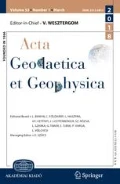Abstract
Geological structure of the salt rock mass and its more than 700-year-old exploitation make the “Wieliczka” Salt Mine an important monument of material and natural values. One of the most interesting objects in the mine are the Crystal Caves, which are globally unique, because of salt crystals (halite) which are covering ceiling and sidewalls. Due to its uniqueness, caves are protected by law and a subject of preventive measures. Because of the tightening forces of excavations (convergence) Crystal Caves must be periodically monitored. It is estimated that the speed of convergence is from 0 to 2 mm/year. In order to monitor changes in the geometry of the excavation and deformation of crystals in the 1960s of twentieth century photogrammetric measurements were performed. They require a lot of work and time, and adversely affect the microclimate in the Crystal Caves. Presented in the article modern geodetic measurement techniques (laser scanning, total station) allow to obtain comprehensive data in a short time. It helped to receive an accurate analysis of the changes in geometry of caves. Proposed in the article measurement procedure determines the range of research, which was carried out in order to fully monitor the tested object. Due to the estimated speed of convergence and the accuracy of the applied technologies measurement series on an annual basis are planned. Comparative analysis of the data obtained in the future, give specific conclusions about the current impact of the rock mass on the Crystal Caves and help to improve prevention.










Similar content being viewed by others
References
Alexandrowicz Z (1994) Crystal Caves—history and present (in Polish with English summary). Chrońmy Przyrodę Ojczystą 50(1):31–46
Alexandrowicz Z (ed) (2000) Crystal Caves in the Wieliczka Salt Mine (in Polish with English summary). Studia Naturae 46:11–18
Alexandrowicz Z, Wiewiórka J (1994) Magnum Sal—world natural heritage monument (in Polish with English summary). Chrońmy Przyrodę Ojczystą 50(4):7–20
Beraldin J-A, Blais F, Cournoyer L, Picard M, Gamache D, Valzano V, Bandiera A, Gorgoglione M (2006) Multi-resolution digital 3D imaging system applied to the recording of Grotto sites: the case of the Grotta dei Cervi. In: The 7th international symposium on virtual reality, archaeology and cultural heritage VAST, Cyprus, 30 Oct–4 Nov 2006. NRC 48791
Borowiec W (1974) Utilization of a stereometric camera to elaborate the documentation of the crystal grotto in Wieliczka (in Polish). Zeszyty Naukowe AGH 445(29):69–82
Borowiec W (1978) Function of photogrammetric methods in documenting historic underground interior (in Polish). Doctoral dissertation, AGH University of Science and Technology, Cracow
Borowiec W, Batko W (1979) Photogrammetric inventory of the underground monuments. In: Materiały na Sympozjum Międzynarodowe zorganizowane przez International Committee of Architectural Photogrammetry: Contribution of Photogrammetry and Geodesy to Revalorisation of Historic Sites, 20–22 June 1979, Kraków
Borowiec W, Mikołajczak J (1977) Selection of the optimum measurement methodology for determining the volume of voids in the caves of the Wieliczka Salt Mine (in Polish). Prace Naukowe Instytutu Geotechniki Politechniki Wrocławskiej, 18. Studia i materiały, 10. Wroclaw
Galamay et al (1997) Origin of the middle Miocene Badenian salts in the Carpathian region (in Polish with English summary). Przegląd Geologiczny 45(10/1):1012–1017
Garlicki A (1994) The formal lithostratigraphic units of Miocene—the Wieliczka formation (fm) (in Polish with English summary). Przegląd Geologiczny 42:26–28
González-Aguiler D, Muñoz-Nieto A, Gómez-Lahoz J, Herrero-Pascual J, Gutierrez-Alonso G (2009) 3D digital surveying and modelling of cave geometry: application to Paleolithic Rock Art. Sensors 9(2):1108–1127
Grussenmeyer P, Landes T, Alby E, Carozza L (2010) High resolution 3D recording and modelling of the bronze age cave “Les Fraux” in Perigord (France). In: International archives of photogrammetry, remote sensing and spatial information sciences, vol XXXVIII, part 5 commission V symposium, Newcastle upon Tyne, United Kingdom
Hejmanowski R (ed) (2001) Predicting rock mass and surface deformations for solid, liquid and gas deposits on the basis of generalised Knothe theory (in Polish). Wydawnictwo IGSMiE PAN, Cracow
Joint Committee for Guides in Metrology (2008) Evaluation of measurement data—guide to the expression of uncertainty in measurement (ISO/IEC Guide 98-3)
Kortas G (ed) (2004) The movement of the rock mass and surface area surrounded by the historic salt mines (in Polish). Wydawnictwo IGSMiE PAN, Cracow
Lerma JL, Navarro S, Cabrelles M, Villaverde V (2010) Terrestrial laser scanning and close range photogrammetry for 3D archaeological documentation: the upper Palaeolithic Cave of Parpalló as a case study. J Archaeol Sci 37:499–507
Markowski J (1982) The problems of the ancient salt mine Wieliczka preservation and protection (in Polish with English summary). Studia i Materiały do Dziejów Żup Solnych w Polsce 11:29–44
Pielok J (2002) Investigations of deformation on area and rock mass caused by mining exploitation (in Polish). AGH University of Science and Technology, Cracow
Rüther H, Chazan M, Schroeder R, Neeser R, Held Ch, Walker SJ, Matmon A, Kolska Horwitz L (2009) Laser scanning for conservation and research of African cultural heritage sites: the case study of Wonderwerk Cave, South Africa. J Archaeol Sci 36:1847–1856
Wędzony J (1990) Lectures about geodetic and adjustment calculus (in Polish). AGH University of Science and Technology, Cracow
Wong U, Morris A, Lea C, Lee J, Whittaker Ch, Garney B, Whittaker R (2011) Comparative evaluation of range sensing technologies for underground void modeling. In: 2011 IEEE/RSJ international conference on intelligent robots and systems, 25–30 Sep 2011, San Francisco, CA, USA
Acknowledgments
Research for the article was funded by statutory research of the Department of Mining Areas Protection, Geoinformatics and Mining Surveying (AGH University of Science and Technology in Kraków) number 11.11.150.195.
Author information
Authors and Affiliations
Corresponding author
Rights and permissions
About this article
Cite this article
Lipecki, T., Jaśkowski, W., Gruszczyński, W. et al. Inventory of the geometric condition of inanimate nature reserve Crystal Caves in “Wieliczka” Salt Mine. Acta Geod Geophys 51, 257–272 (2016). https://doi.org/10.1007/s40328-015-0125-5
Received:
Accepted:
Published:
Issue Date:
DOI: https://doi.org/10.1007/s40328-015-0125-5




